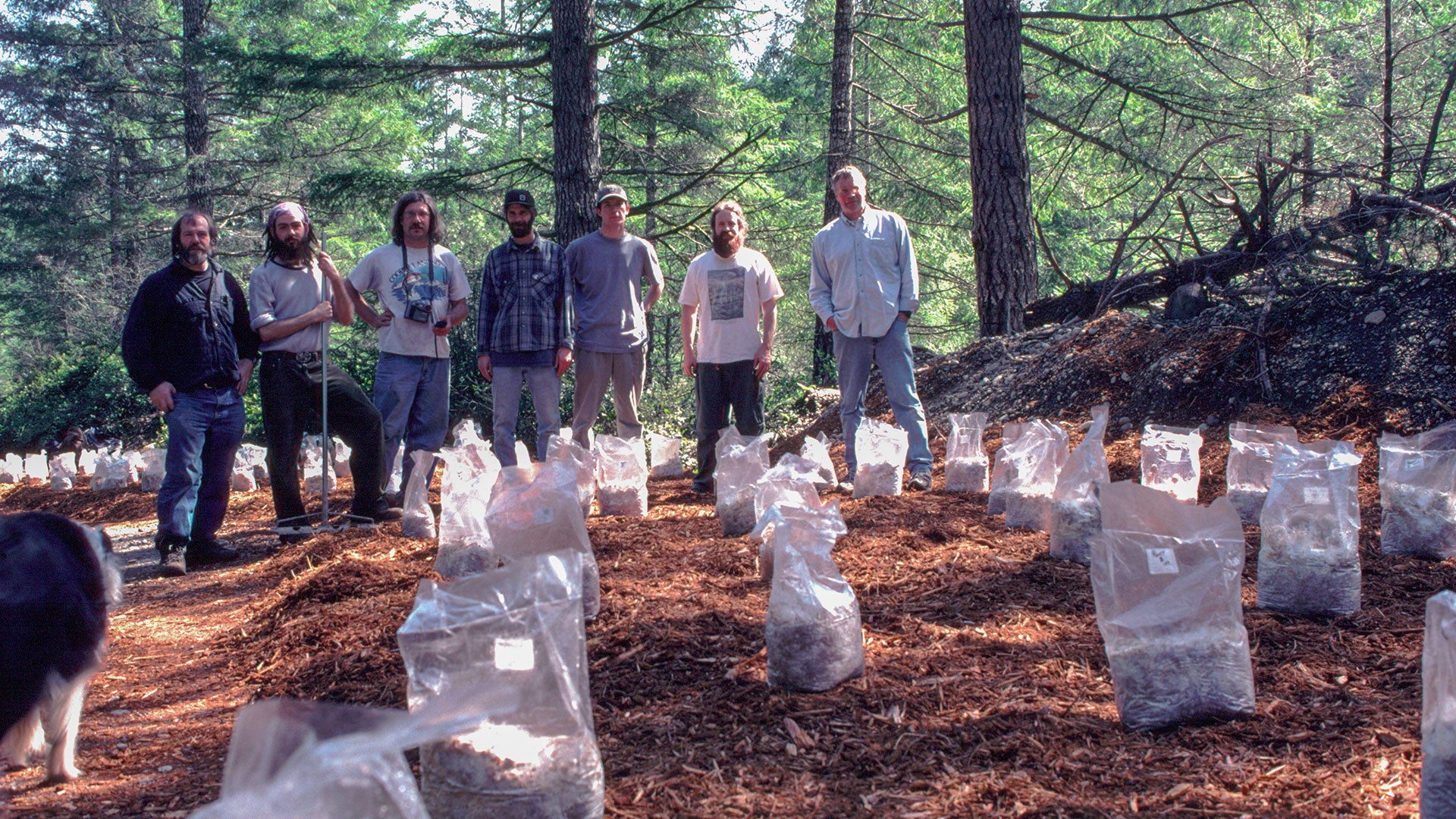
MycoRestoration of Abandoned Logging Roads
by Paul Stamets, Inventor & David Sumerlin, Project Manager
(Several concepts, techniques, & products described herein are currently protected by pending patents and copyrights of Paul Stamets, who reserves all rights.)
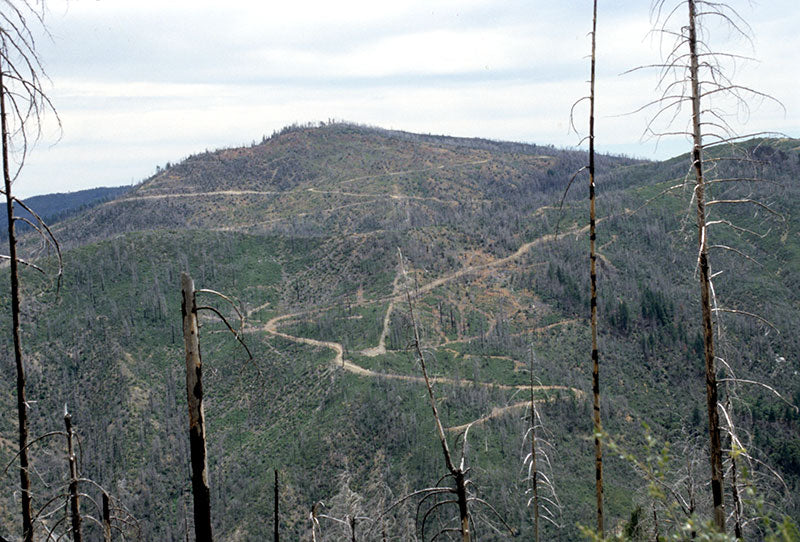
The Problem: Logging road networks such as this site in Northern California channel silt into salmon streams and impedes habitat restoration. Such roads are slow to recover. (Amaranthus & Trappe, 1993.)
|
"Our number one water quality problem in the National Forests is roads." –Under Secretary of Agriculture Jim Lyons, 2000 |
Thousands of miles of logging roads channel run-off from uplands, silting salmon spawning streams, dramatically reducing their reproductive habitats. The deactivation of logging roads poses a unique and heretofore poorly understood process. What is known is that the run-off of water from rains causes massive environmental havoc in the form of erosion, removing life-sustaining top soils, causing sedimentation and siltation inflows into downstream watersheds.
With each successive tree-crop cycle, environments lose topsoils, slowing ecological recovery. In the not-too-distant future, as Washington State forests face 3rd, 4th, and soon 5th growth forests, the impact of thinning soils becomes more severe. Unless the depletion of the nutritional topsoil bank is addressed, the future economic return from Washington State forests is increasingly jeopardized by current practices. Washington State is not alone. The problem of roads causing ecological damage is universally shared throughout the world.
For every mile of paved road in Washington State, there are more than 7 miles of unpaved roads. Washington State budgeted $165,000 in 2001 for the decommissioning of roads. In contrast, in 1999, the Forest Service budgeted $25,000,000 for federal lands. Increasingly state and federal governments have targeted roads as the primary vector of siltation and pollution to watersheds and sensitive ecosystems. Estimates for deactivating roads range from $4100 to $15,500 for every mile (Garrity, 1995) in the Northern Rockies to $21,000 to $105,600 per mile in the Olympics and Cascades. (Seaburg, 2001). The cost of building a road in Washington State is estimated at $600-2000 per hundred feet, or approximately $32,000+ per mile. The cost of destroying or building a road, using current methods, is roughly within the same range. As there is little precedent for an acceptable standard of decimation, restoration experts can benefit by adapting to mycofiltration delivery systems.
We propose a new approach. The intention herein is to take the first steps in addressing a simple solution to a complex field of problems. When the full costs are taken into consideration, ecologically (i.e. forests & fish ecology), economically (lumber, road construction, access), and aesthetically, mycofiltration is worthy of serious consideration. What we propose is simple yet highly effective.
Place 'hog-fuel' (bark and wood chips) onto logging roads, and inoculate this wood debris with mycelia of a mosaic of keystone native fungal species. The fungified wood chips prevent silt-flow through the natural filtration properties of their mycelial networks, and in the process renew topsoils, spurring the growth of native flora and fauna.

Scanning Electron Micrograph of Mycelium, magnified 500 X (P. Stamets)
This concept, coined by Stamets as 'mycofiltration' has gained significant attention by the Battelle Marine Science Laboratories in Sequim, Washington, and was funded by more than $300,000 in research money. The beneficial properties of using fungal mycelium have been well established. (Stamets et al., 1999). The use of buffers to ameliorate the impact of nitrates, pesticides and hydrocarbons is now being recommended to control pollution vectors. (Straight, 2000; Bagdon, 2000). The use of wood chips applied to road surfaces has demonstrated a positive impact on reducing sedimentation. (Hickenbottom, 2000; Madej, 2000; Prescott, 2001).
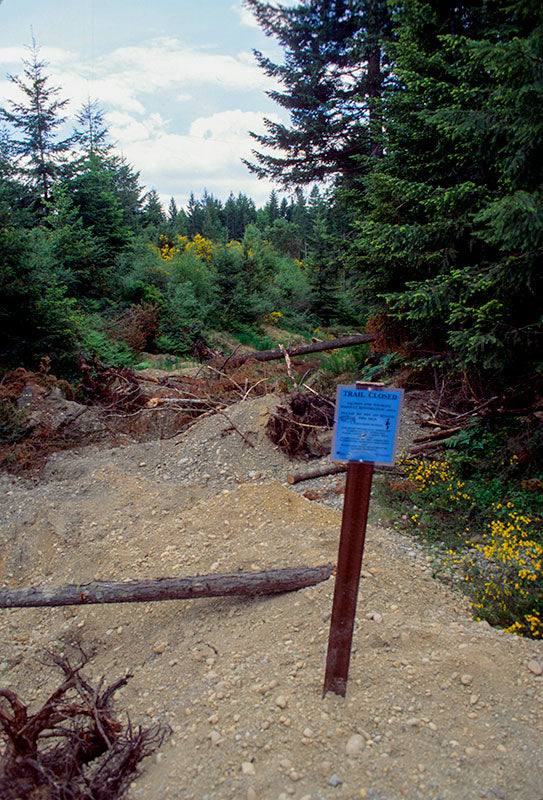
A solution? Or a bad idea made worse? What is the best way to deactivate an old logging road? This 'Terra Interruptus' approach: expensive, burdensome, invasive, destructive, erosive and nearly impassable.
The building of roads and the resultant compaction creates an environment absent in mycorrhizal fungi (Amaranthus & Trappe, 1993; Amaranthus 1996), hindering recovery of native flora, and thus habitat restoration. Should a new forest practices model be established which would provide a value-added incentive for the woods product industry to leave or return this waste-wood back to the lands from which they came; many problems could be addressed with one practical solution. Such an approach has been explored in British Columbia, which has modeled a decision-making tree for evaluating sites. (Allison & Tait, 2000).
The novelty of mycofiltration is the purposeful introduction of fungi, saprophytic and mycorrhizal, to the wood chip buffers, enhancing effectiveness by accelerating decomposition. Spores infused into chain-saw bar oil or into the lubricating oil for chippers expose the wood immediately upon cutting to fungi that can begin the decomposition sequence. Or once in place, spores or spawn can be broadcasted onto the chipped wood as shown. In either case, accelerating the sequence of decomposition is essential for habitat evolution. Our method jump-starts the process of recovery, allowing nature to steer the course of species succession after inoculation. The benefits become soon apparent after application.
The advantages of using mycofiltration mats upon logging roads compared to the use of heavy equipment to achieve the tank-trap, scarification or 'terra interruptus' approach are listed below.
|
Advantages of Mycofiltration vs. Conventional Road Decommissioning Sediment containment Moisture enhancement Habitat recovery & Enhancement Reduction/elimination of Hydrocarbon contamination Reduction/elimination of damaging downstream microorganisms Temperature reduction Minimal disturbance Subsurface penetration by mycelium Aesthetic enhancement Educational showcase Bad bugs/Good bugs* Investment Protection |
Obviously, we cannot perpetually draw from the ecological bank of forestlands without returning nutrition back to the system. We urge the establishment of a team to investigate and propose the concept of mycofiltration within a new economic model that synergistically combines the needs of Washington States' schools, timber harvests, fisheries, road reclamation, habitat recovery, and accessibility for recreational use.
Although Fungi Perfecti LLC is a small company, we have sufficient experience to launch this concept at several test sites. However, we lack the economic muscle to do so beyond a few demonstrations. Deactivation of roads is also a concern for arid lands, especially those bordering rivers, which also benefit from habitat buffers. (Bagley, 1999.) No matter what the location, we can utilize native species of fungi to help Nature recover.
*Research by Stamets shows that beneficial insects, such as Phorid flies can be attracted to certain mycelia. Phorid flies are a known predator of fire ants(Solenopsis invicta). Mycelia emit a fragrance that can attract Phorid flies from afar, concentrating them, and thus directing them to fire ant target colonies. This is but one example of potentially hundreds of pairings described in patents, approved and pending, by Stamets. See U.S. Patent pending serial #: 09/678,141 at http://www.uspto.gov/.

Tahuya State Forest Reclamation Test Site
Tahuya State Forest is located on the southern Kitsap peninsula in Washington State. It is a 23,100-acre multi-use forest available to hikers, motorcyclists, bicyclists and horses. This is a working forest with revenue from it goes to fund the Mason county school system.
We contacted the Department of Natural Resources to explore whether or not they were interested in projects using fungi as keystone species for reclamation. Phil Wolff, the SEPA contact person for this district directed us to the study sites within Tahuya State Forest, directly outside of Belfair.
The road has been blocked to limit use, as DNR is conducting a salmon stream rehabilitation project along the bottom of the road. On one reclaimed site, grass seed was sown directly on the bare soil along the same salmon stream. In seven years the site has been slow to recover with a thin layering of grass. The habitat lacks biological diversity, has very little soil, no under-canopy, and the rate of recovery has been exceedingly slow. The following photograph clearly demonstrates the problem: the run-off is saturated with silt that directly runs into the salmon spawning grounds of the Tahuya River.
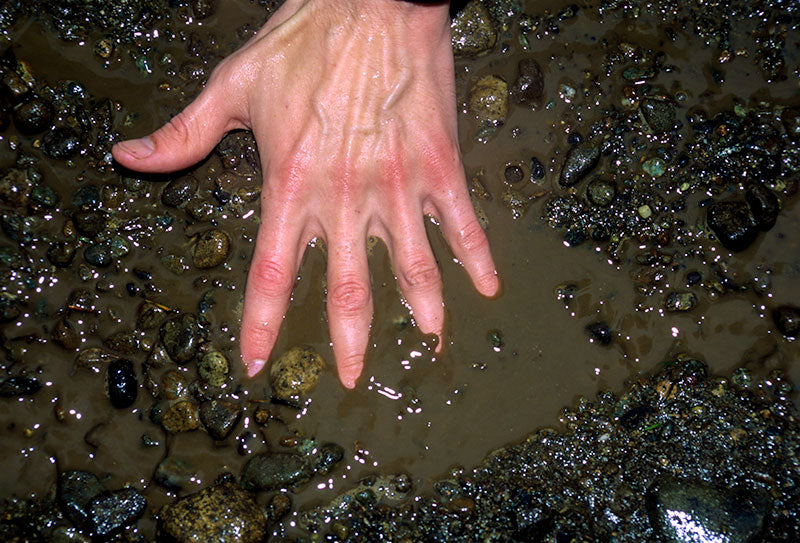
Silt-saturated run-off photographed during a rain event at the test site prior to application of mycomats.
DNR allocated a swath of upland road destined for habitat recovery above aforementioned salmon habitat. Our project is a hundred yards from the grass-remediated site and two hundred from the costly and labor-intensive 'Terra Interruptus' destructive reclamation site. Our portion of the reclamation area is a 500-foot stretch of road on a hill that bottoms near the salmon stream. This section of roadway is still used for ORV travel and we were authorized to reclaim only half of the road to preserve access for recreational users. Along this 500-ft section we set up three experimental zones for our mycoremediation trials. The lower section of the road has the greatest slope and the most erosion potential. The middle section of the road was fairly wide (30 ft.+) with a sloping bank. Our intention is to prevent further bank erosion as well as filter the flow of silt-enriched water. We arranged for the delivery of 'hog-fuel', a crude mixture of bark, wood chips, and fir needles, in 10-yard loads. North Mason Fiber donated the hog fuel while Fungi Perfecti paid for the trucking. Seven employees donated their time to spread material. The crew ('Team MycoForce') spread the wood chip matrix to a depth of 3 to 12 inches. After the hog-fuel was spread, we applied spawn of a native mushroom species, the Oyster Mushroom, Pleurotus ostreatus, on the top surface of the hog-fuel. Six bales of wheat straw were spread out over the top.
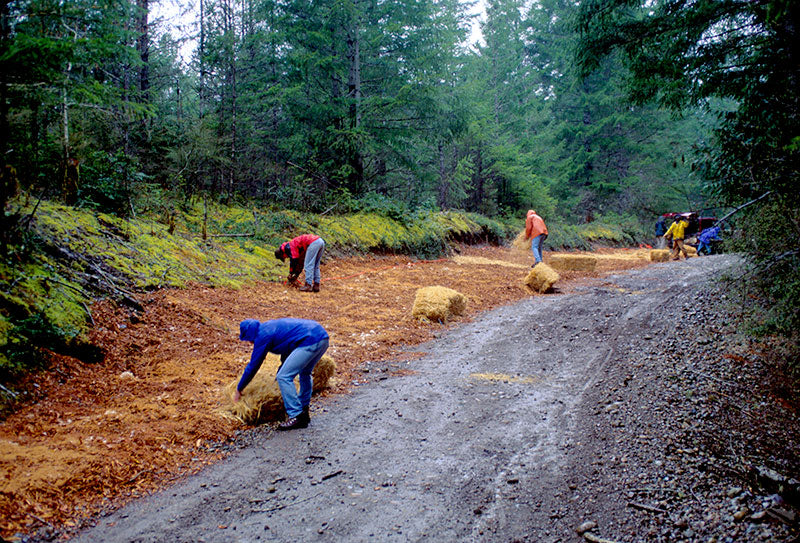
Overlaying wood chips with wheat straw, after inoculation with mycelia. Note active siltation flow on right road surface.
The straw acts as a protective layer, holding in moisture and preventing the spawn from drying out. We seeded the sites using a broadcaster filled with MycoGrow®, a mycorrhizal inoculum, and Regreen®, a non-seeding wheat approved for erosion control. Twenty pounds of seed and one pound of mycelial inoculum were broadcast over the straw. This site was inoculated over two days on the 11th and 12th of April, at the time of intermittent, heavy rainfall.
In one week, upon returning to the site, we found the habitat was in its first stages of growth. Seeds of Regreen® were starting to sprout and mushrooms were seen fruiting from the spawn we introduced. We selected the Oyster Mushroom, Pleurotus ostreatus, as our keystone species, a primary saprophyte, known for its aggressiveness, and adaptability for growing under a variety of conditions and temperatures. Future installations will be using a matrix of white rot, brown rot, and diverse mycorrhizal species. No parasitic species are contemplated.
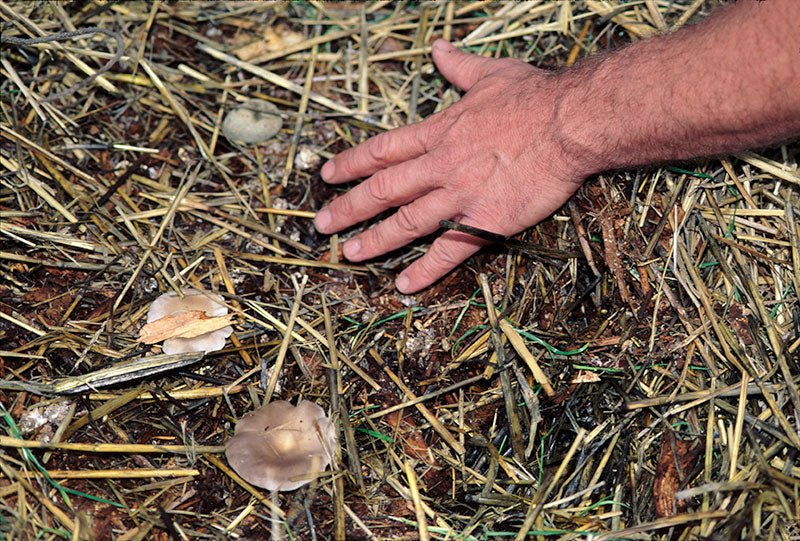
Pleurotus ostreatus, the Oyster Mushroom, fruiting from mycoblanket four weeks after overlaid upon road surface at the Tahuya site.
As the mushrooms grow to maturity, spores are released, further inoculating the surrounding hog fuel and straw, giving rise to more mycelium and further colonizing the substrate. As the mycelium permeates the wood substrate, moisture retention is enhanced. The mushrooms also act as an attractant to native insects. The rotting mushrooms become a breeding ground for fly larvae and grub, which, in turn, further enrich the salmon stream ecosystem. Once a mycofiltration habitat is constructed, a domino effect of ecological recovery unfolds, and Nature guides its future course.
In the fall, native ferns will be harvested nearby and dressed upon the mycofiltration beds, leading to visible growth the next year. As the wheat straw climaxes and dies, and as the wood chips decompose, a rich soil is created, further nurturing the recovery of native species. After several years, a mantle of mycelium forms at the wood chip/gravel interface (See below). This sheath of mycelium overlays and hold the gravel together, furthering adding structural resilience to the road's subsurface.
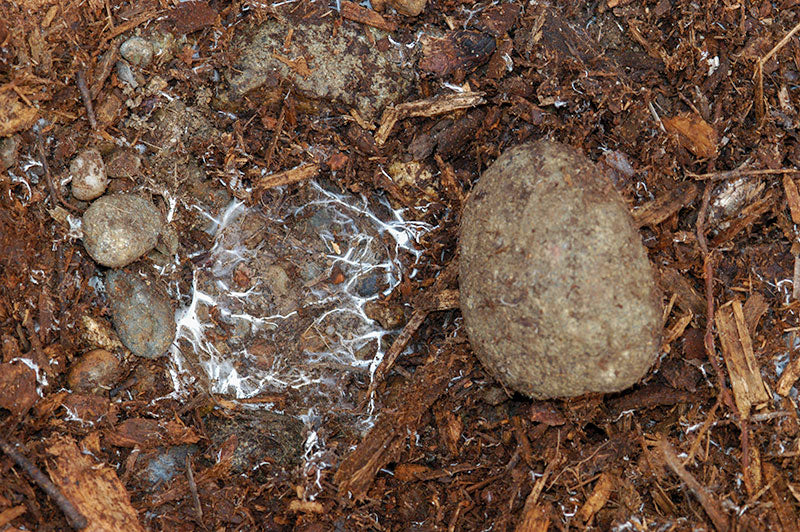
After three years, an inspection of the reclaimed road showed a mantle of nearly contiguous mycelium at the wood chip/gravel interface, holding the sub-moraine together. One hypothesis is that the mycelium became resident in this zone, feeding upon the sheet flow of nutrified water along this interface. This photo shows an overturned rock which had beneath it a bed of mycelium. This sheath of mycelium extended for meters in all directions, securing the gravel in its grip.
For every 10 inches of wood chips, we estimate the creation, after 4 years, of 1-2 inches of soil. In the meanwhile, once ugly roads, the source of numerous economic and ecological problems, are transformed into green, foot-friendly pathways usable to both humans, fauna, flora and fungi. This approach is simple, direct, and directly applicable, especially where forests are being thinned from selective logging. However, only if mycorestoration succeeds economically, will there be any possibility of wide scale use on government and private lands. We ask your support in investigating mycofiltration as a new best management strategy for long-term sustainability of our forestlands. We believe placing myco-blankets well serves the best interests of the people and the environment. Our services are available to help move this concept forward.
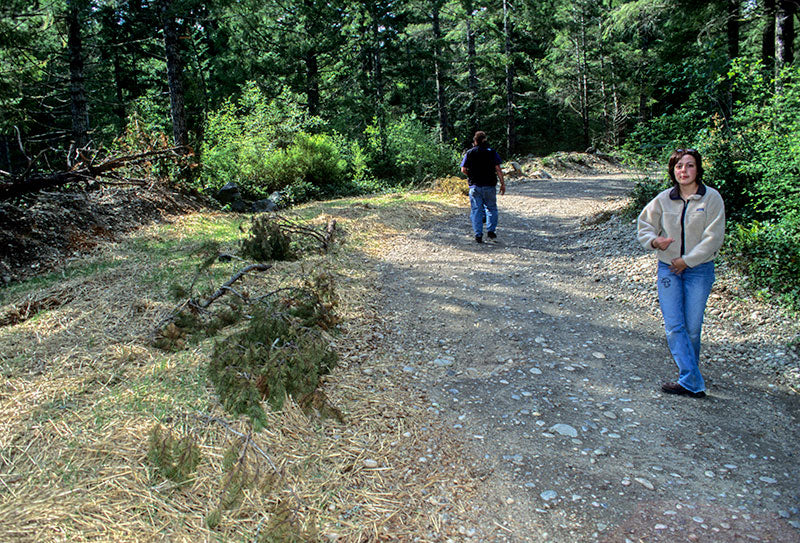
5 weeks after installation, the habitat re-greens in the wood chip beds. The habitat is in an active state of recovery, and becomes a naturally cooler & moister environment. The grass will draw in moisture through atmospheric condensation and, in doing so, aids mycelial growth. The beds are 'foot friendly' environments, being a cushion of wood chips up to 12 inches thick.
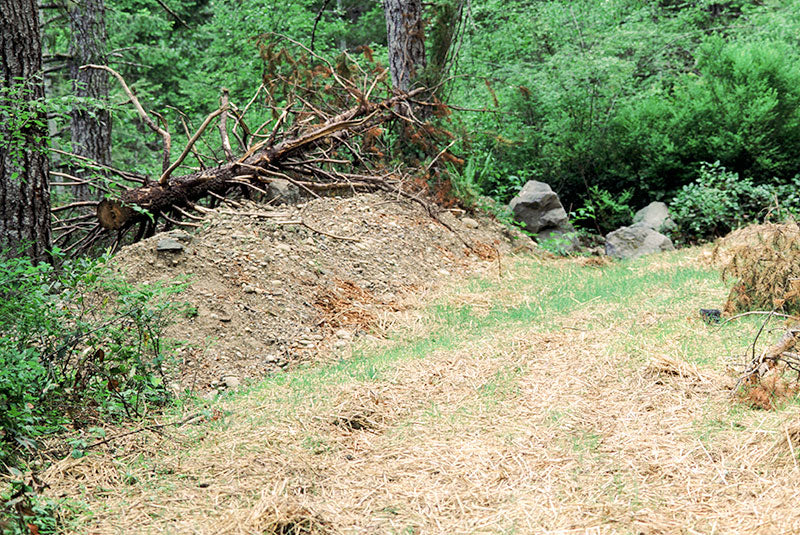
Mycomatting to the edge of roads creates a filtration interface, preventing rivulation and ameliorating erosion forces.
On-Going Restoration Projects Which Could Benefit From Mycofiltration
University of British Columbia, Science Council of British Columbia. C. Prescott Project: Rehabilitation of Forest Roads and Landings with Wood Waste
Pertinent References on Road De-Activation
Allison, C. & D. Tait, 2000. "The Application of Decision Analysis to Forest Road Deactivation Problems - an Example in Coastal British Columbia" Streamline: Watershed Restoration Technical Bulletin Vol. 5; no. 2 pgs. 1-11.
Amaranthus, M. & J. Trappe, 1993. "Effects of erosion on ecto- and VA-mycorrhizal inoculum potential of soil following forest fire in southwest Oregon.Plant & Soil150: 41-49.
Bagley, S. 1999. "Desert Road Removal: Creative Restoration Techniques" from Road RIP-Porter 4.4.
Hickenbottom, J. A.S., 2000. "Comparison of Sediment Generation from Existing and Recontoured Forest Service Road" USDA Forest Service, Lolo National Forest, Missoula, MT
Madej, M.A., 2000. "Effectiveness of Road Restoration in Reducing Sediment Loads" Western Ecological Research Center.http://www.werc.usgs.gov/redwood/restoration.htm
Prescott, C., 2001. "Rehabilitation of Forest Roads and Landings with Wood Waste" University of British Columbia, Science Council of British Columbia.
Straight, R., 2001. "Getting buffers on the ground: a group effort"Inside Agroforestry3, pp. 1-7. National Agroforestry Center, East Campus-UNL, Lincoln, Nebraska 68583-0822. USDA
Stamets, P., 1993. "Mycofiltration of gray water run-off utilizingStropharia rugoso-annulata, a white rot fungus." Research Project awarded a grant by the Mason County Water Conservation District, Shelton,Washington.
_____, 2001. "A novel approach to farm waste management".Mushroom, the Journal70: vol. 19, no. 1:21-22.
______, 2003.Mycoattractants & Mycopesticides:U.S. Patent pending Serial #: 09/678,141. Approved 8/2003. Issuance numbers imminent.
Copyright by Paul Stamets
PO Box 7634 • Olympia, Wa. 98507
Ad-hoc Mycofiltration Team Leaders:
Jack Word
Bob Sagar
Michael Garling
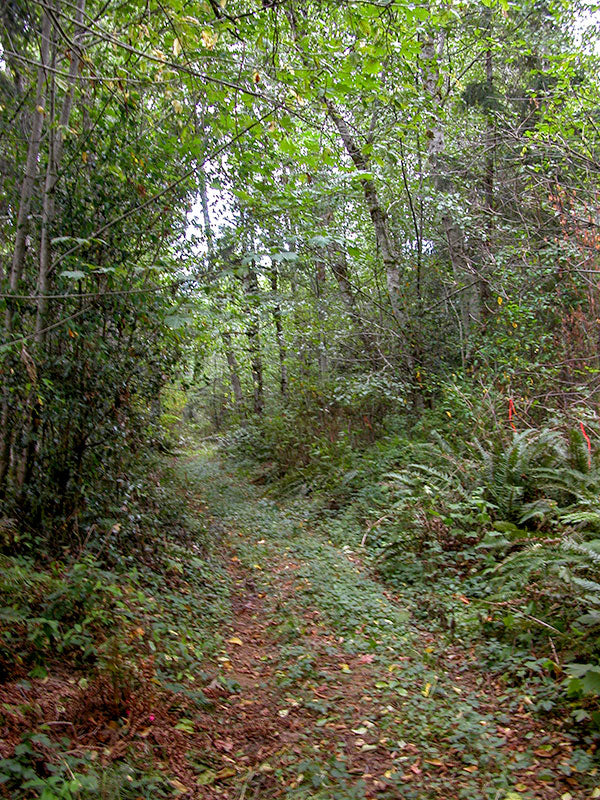
This retired logging road is now a foot friendly path attractive to wildlife and humans alike, and slowly narrows with encroaching vegetation over time.
